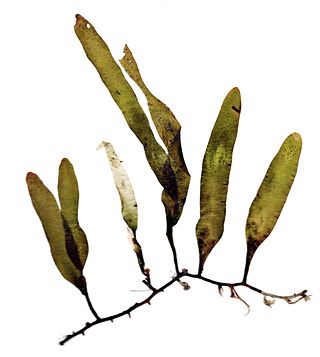
Caulerpa is a genus of seaweeds in the family Caulerpaceae. They are unusual because they consist of only one cell with many nuclei, making them among the biggest single cells in the world.

Caulerpa racemosa is a species of edible green alga, a seaweed in the family Caulerpaceae. It is commonly known as sea grapes and is found in many areas of shallow sea around the world. Despite the name, it is not related to grapes. There are a number of different forms and varieties, and one that appeared in the Mediterranean Sea in 1990, which is giving cause for concern as an invasive species.

Gracilaria is a genus of red algae (Rhodophyta) notable for its economic importance as an agarophyte, as well as its use as a food for humans and various species of shellfish. Various species in the genus are cultivated among Asia, South America, Africa and Oceania.
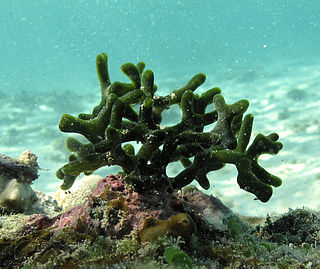
Codium is a genus of edible green macroalgae under the order Bryopsidales. The genus name is derived from a Greek word that pertains to the soft texture of its thallus. One of the foremost experts on Codium taxonomy was Paul Claude Silva at the University of California, Berkeley. P.C. Silva was able to describe 36 species for the genus and in honor of his work on Codium, the species C. silvae was named after the late professor.
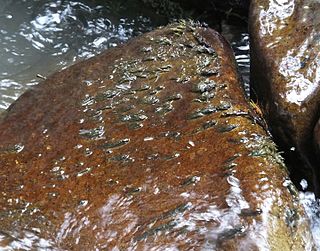
Lemanea is a genus of freshwater red algae, in the order Batrachospermales. Both species are considered to be widespread in the northern hemisphere. Although placed in the Rhodophyta it in fact is green in colour.

Udotea is a genus of green algae in the family Udoteaceae.

Turbinaria is a genus of brown algae (Phaeophyceae) found primarily in tropical marine waters. It generally grows on rocky substrates. In tropical Turbinaria species that are often preferentially consumed by herbivorous fishes and echinoids, there is a relatively low level of phenolics and tannins.

Gelidium amansii, also known as umutgasari, is an economically important species of red algae commonly found and harvested in the shallow coast of many East Asian countries including North and South Korea, China, Japan, Singapore, and northeast Taiwan. G. amansii is an important food source in East Asian countries and has been shown to have medicinal effects on dieting. Hence, in folklore medicine G. amansii is used to treat constipation. This algae is used to make agar, whose components are the polysaccharide agarose and agaropectin, from the large amount of algin which is located in the algae's cell wall, as well it is sometimes served as part of a salad, puddings, jams, and other culinary dishes in producing regions. Agar is a gelatinous substance that is commercially used both as an ingredient in gelatinous desserts and as an incubation matrix for microbes and other products that require an ecologically friendly gelatinous matrix. G. amansii can be purple, red, to yellowish-red because it contains the class of pigments known as phycobiliprotein. Its branching body is cartilaginous and can grow up to a height of 8 to 30 cm or 3 to 12 in. G. amansii may have four or five opposite, compound-lobed, pinnate leaves on each branch. It is uniaxial with an apical cell and whorled cells coming from the axial towards the exterior of the algae. The pith is compacted with apical cells and the epidermis is formed by rounded whorled cells. G. amansii is being studied as a cheap biofuel.
Bangia is an extant genus of division Rhodophyta that grows in marine or freshwater habitats. Bangia has small thalli with rapid growth and high reproductive output, and exhibits behavior characteristic of r-selected species. The plants are attached by down-growing rhizoids, usually in dense purple-black to rust-colored clumps. The chloroplasts of Bangia, like others in the division Rhodophyta, contain chlorophyll a and sometimes chlorophyll d, as well as accessory pigments such as phycobilin pigments and xanthophylls. Depending on the relative proportions of these pigments and the light conditions, the overall color of the plant can range from green to red to purple to grey; however, the red pigment, phycoerythrin, is usually dominant.

Hydroclathrus is a genus of perforate brown alga, of the phylum Ochrophyta and the class Phaeophyceae.

Lobophora is a genus of thalloid brown seaweed of the Phylum Ochrophyta; Class Phaeophyceae.
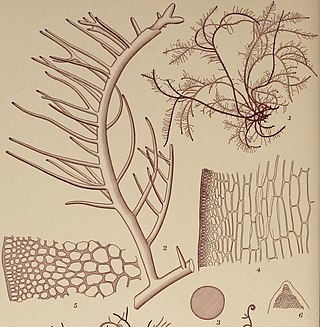
Hypnea is a genus of red algae, and a well known carrageenophyte.

Caulerpa sedoides, also known as mini-grapes or bubble caulerpa, is a species of seaweed in the Caulerpaceae family native to Australia.

Dictyota is a genus of brown seaweed in the family Dictyotaceae. Species are predominantly found in tropical and subtropical seas, and are known to contain numerous chemicals (diterpenes) which have potential medicinal value. As at the end of 2017, some 237 different diterpenes had been identified from across the genus.
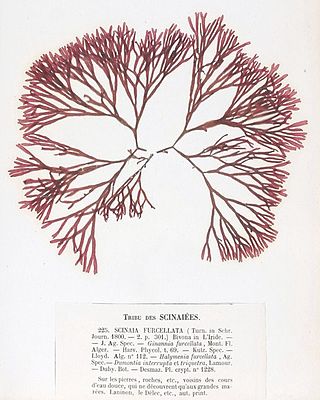
Scinaiaceae is a family of red algae (Rhodophyta) in the order Nemaliales.













